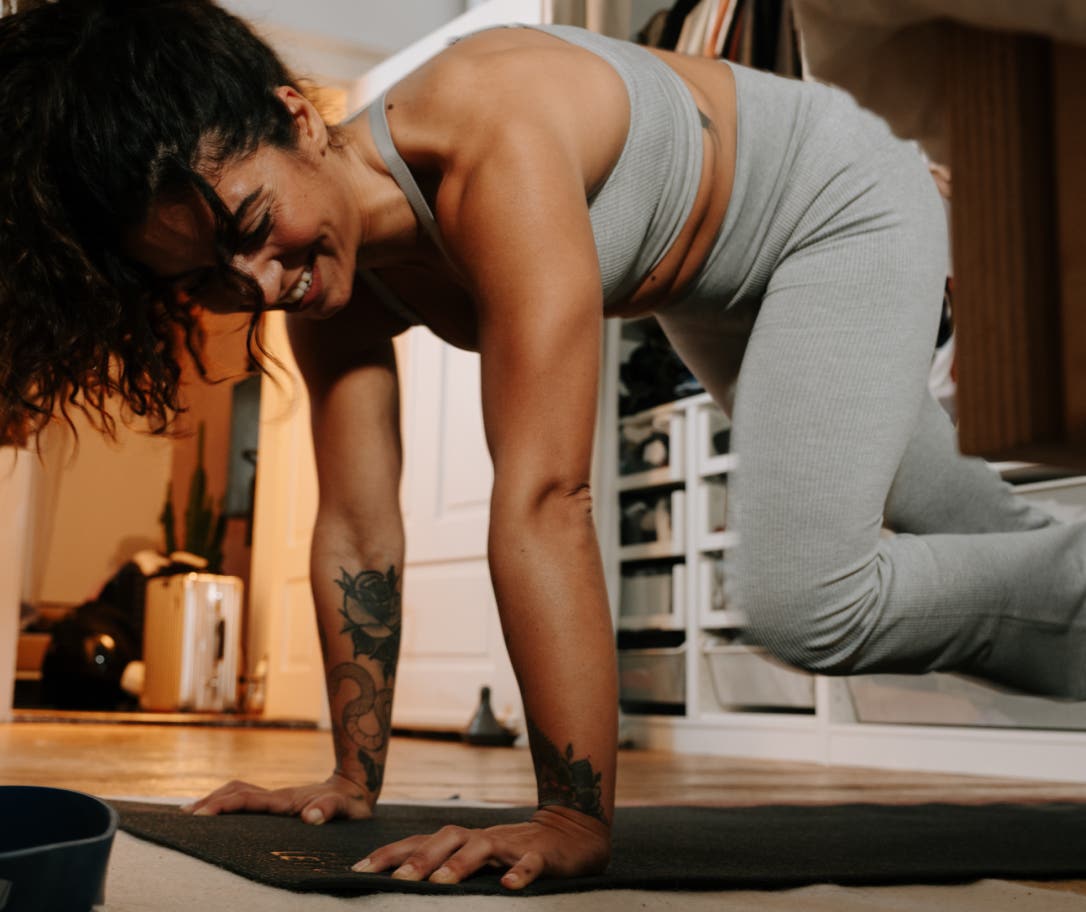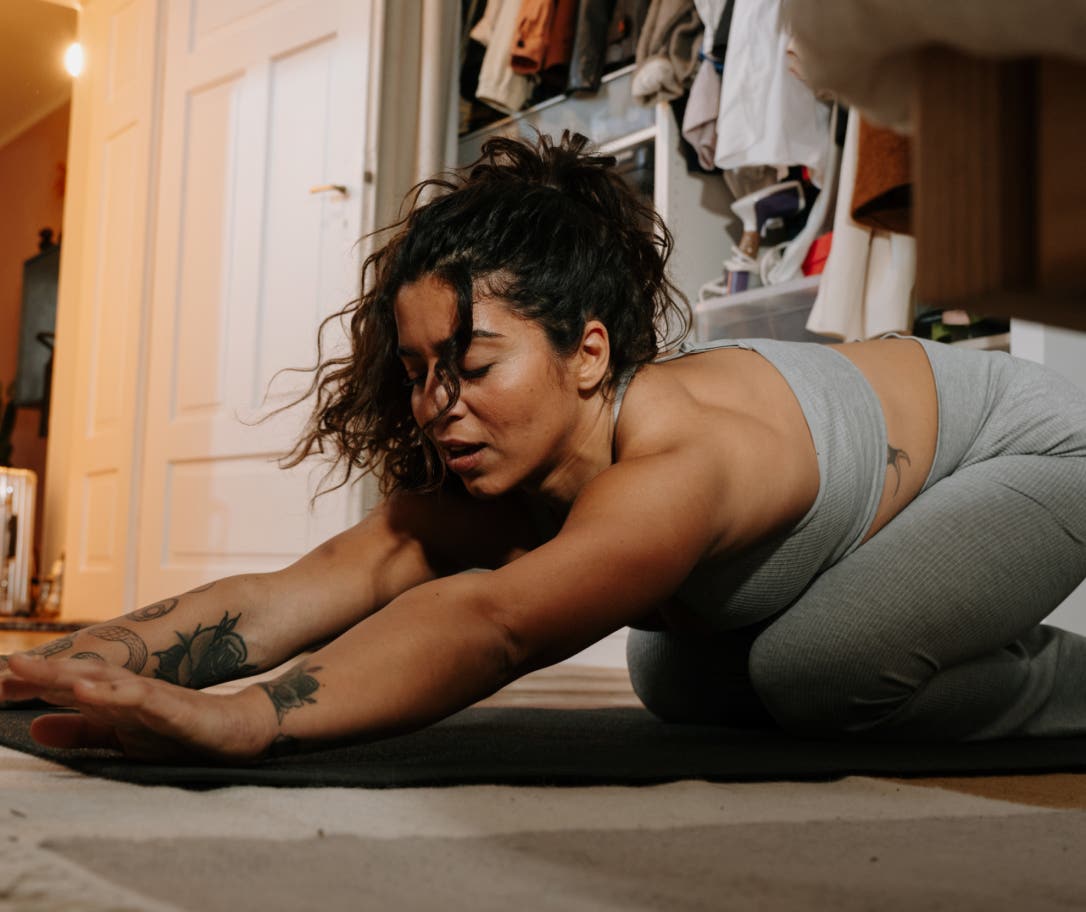Regular exercise is one of the best things you can do to improve the quality of your sleep. It helps you fall asleep quicker, stay asleep longer, and wake up feeling more refreshed. However, the type of exercise you do, how hard you work out, and when you work out can all influence your sleep quality in different ways.
Here, we break down what’s going on inside your body and brain when you exercise and how to fine-tune your workouts to support deep, restorative sleep and your overall health.
Effects of training on the body and central nervous system
Exercise doesn’t just benefit your muscles; regular physical activity plays a vital role in supporting your nervous system and brain health. When you work out, your sympathetic nervous system kicks in, which puts your body in a state of heightened alertness, otherwise known as “fight or flight” mode.
It helps the body cope with the increased metabolic demands, leading to an increased heart rate, respiration, and blood pressure, which ensures an adequate blood flow and oxygen to the working muscles.1
Following exercise or at rest, your body shifts into the parasympathetic nervous system, which helps your body recover and wind down.2 However, the transition from the sympathetic to the parasympathetic nervous system can vary, depending on how close to bedtime you train or how intense your workout is, making it harder to relax and sleep.

How different types of exercise have different effects on sleep
Different types of exercise can impact sleep in different ways. Understanding the differences between the training intensities can help you structure your workouts more strategically and help you plan for a better night’s sleep.
High-intensity
High-intensity training like HIIT, sprinting, and high-output sessions can leave your nervous system buzzing, especially if you do it late in the day. High-intensity training sessions increase cortisol levels and body temperature, which can delay sleep if done too close to bedtime.
Timing HIIT sessions, like in the morning or early afternoon, may improve sleep quality. However, individual responses can vary, so it’s important to find what works best for you. One study showed that sleep quality was poorer in the morning-type rather than evening-type football players after an evening HIIT session.3
Low-intensity
Low-intensity exercise like walking, gentle stretching, mobility, or yoga helps ease your body into a parasympathetic state. These activities are ideal for evening exercise, especially when you want to move without overstimulating your system. Some research shows that low-intensity exercise in the evening can improve self-reported sleep quality4 and even shorten the time it takes to fall asleep.5
Heavy weights
Resistance training, particularly when you incorporate progressive overload, can significantly improve the quality of your sleep over time.6 Weight training increases the buildup of the neurotransmitter, adenosine, which promotes sleepiness.7
Advanced bodyweight movements (calisthenics)
Movements that involve using your own bodyweight, or calisthenics, are physically demanding and require significant mental focus. These workouts can be energizing and stimulating, and can improve sleep quality and prevent fatigue.8

Does the time of day you work out matter?
The time of day that you choose to exercise can affect your sleep, but it also depends on your individual response and exercise intensity. Generally, as mentioned above, morning workouts might improve your overall sleep quality and help you fall asleep faster, whereas those intense HIIT sessions done later in the day might leave you counting sheep or even impact the overall quality of your sleep.
Morning training
Exercising in the morning has been shown to align your circadian rhythm, a natural internal body clock that regulates your sleep-wake cycle.9 For example, morning light exposure plus physical activity can improve the production of melatonin later in the evening, helping you to fall asleep faster and wake up more alert.
Afternoon training
Some people believe that mid-to-late afternoon is the sweet spot when it comes to choosing the right time to exercise for better sleep. That’s because training at this time gives your body enough time to deal with raised body temperature and cortisol, lowering them enough to prevent any disruption to your sleep. This makes the afternoon an ideal time for more intense workouts.
Some research shows that afternoon exercise has a more positive effect on sleep than morning exercise.10
Evening training
Although you may be apprehensive about exercising in the evening, it can be beneficial for some types of activity. One study found that even moderate exercise delayed sleep when it was carried out in the evening compared to the morning.11
While another study found that this type of exercise in the evening was most associated with improving sleep, low-intensity exercise shortened the time it took to fall asleep, and high-intensity exercise reduced rapid eye movement (REM) sleep.5
Your body temperature regulates your sleep
If you work out too hard or too close to bedtime, it can raise your core body temperature, delaying melatonin release, a hormone that signals to the brain it’s time to sleep. A slight fall in your core body temperature is a natural part of falling asleep12, and it naturally decreases throughout the night, reaching its lowest temperature 1 to 2 hours before you wake up.
As your core body temperature falls, your melatonin levels rise. Together, this promotes a feeling of sleepiness, preparing your body for rest.
How close to bedtime can you exercise?
Light exercise, such as yoga and gentle stretching, is okay if you leave at least an hour before bed. This short buffer helps your body to cool down, switch to the parasympathetic nervous system to promote rest, and start producing melatonin, the hormone that signals it’s time to sleep.
As a general rule, pushing through a tough run, ride, or HIIT workout within 4 hours of bedtime can make it harder to wind down.
But, of course, there’s an exception to every rule, and some people can work out later without any sleep disruption. The key is to listen to your body and track how your workouts affect your sleep patterns over time.

5 tips for cooling and winding down after a late workout
If evening workouts are your only option to stay on track with your fitness goals, here are a few ways you can help your body prepare for sleep:
1. Take a colder shower
A cool or even lukewarm shower can help lower your body temperature and signal to your body that it’s time to wind down and prepare for sleep.
2. Try some gentle stretches
Gentle static stretches can improve flexibility, reduce muscle stiffness, and promote mental calm.
3. Avoid bright screens
Avoid screens that emit blue light, such as cell phones, laptops, and televisions, for 2 hours before bedtime, as blue light can prevent melatonin production, keeping you awake.
4. Practice breathing exercises
Try taking some deep breaths or doing some other breathing exercises to activate your parasympathetic nervous system and promote calmness and rest.
5. Sleep in a cool, dark bedroom
Be sure to keep your sleep environment cool, dark, and clean to promote feelings of restfulness and to help naturally lower your body temperature. Establishing a regular nightly routine, such as going to bed at the same time each night, can be highly beneficial for preparing your body for sleep.
Let’s recap
Exercise and sleep go hand in hand. Regular workouts, when done at the right time and at the right intensity, can greatly improve sleep quality, extend its duration, and support faster recovery.
Switch up your routine and experiment with different workout times to discover what works best for you – your body, mind, and overall exercise performance will thank you.
Sources
[1] Patel PN, Horenstein MS, Zwibel H. Exercise Physiology. [Updated 2024 Oct 6]. In: StatPearls [Internet]. Treasure Island (FL): StatPearls Publishing; 2025 Jan-.
[2] Daniela, M., Catalina, L., Ilie, O., Paula, M., Daniel-Andrei, I., & Ioana, B. (2022). Effects of Exercise Training on the Autonomic Nervous System with a Focus on Anti-Inflammatory and Antioxidants Effects. Antioxidants (Basel, Switzerland), 11(2), 350.
[3] Dote-Montero, M., Carneiro-Barrera, A., Martinez-Vizcaino, V., Ruiz, J. R., & Amaro-Gahete, F. J. (2021). Acute effect of HIIT on testosterone and cortisol levels in healthy individuals: A systematic review and meta-analysis. Scandinavian journal of medicine & science in sports, 31(9), 1722–1744.
[4] Seol, J. et al. (2021) ‘Distinct effects of low-intensity physical activity in the evening on sleep quality in older women: A comparison of exercise and housework’, Experimental Gerontology, 143, p. 111165.
[5] Yue, T., Liu, X., Gao, Q., & Wang, Y. (2022). Different Intensities of Evening Exercise on Sleep in Healthy Adults: A Systematic Review and Network Meta-Analysis. Nature and science of sleep, 14, 2157–2177.
[6] Gupta, S., Bansal, K., & Saxena, P. (2022). A clinical trial to compare the effects of aerobic training and resistance training on sleep quality and quality of life in older adults with sleep disturbance. Sleep science (Sao Paulo, Brazil), 15(2), 188–195.
[7] Kovacevic, A. et al. (2018) ‘The effect of resistance exercise on sleep: A systematic review of randomized controlled trials’, Sleep Medicine Reviews, 39, pp. 52–68.
[8] Cetıslı-korkmaz, N. et al. (2023) ‘The effects of calisthenic exercises on sleep quality, fatigue, and depression in elder adults’, Türk Fizyoterapi ve Rehabilitasyon Dergisi, 34(3), pp. 357–366.
[9] Thomas, J. M., Kern, P. A., Bush, H. M., McQuerry, K. J., Black, W. S., Clasey, J. L., & Pendergast, J. S. (2020). Circadian rhythm phase shifts caused by timed exercise vary with chronotype. JCI insight, 5(3), e134270.
[10] Yosiaki, S. et al. (1998) ‘Afternoon exercise improves the quality of night sleep: A case study observed by EEG and Self‐rating scale’, Journal of Occupational Health, 40(1), pp. 37–43.
[11] Saidi, O. et al. (2021) ‘Effect of morning versus evening exercise training on sleep, physical activity, fitness, fatigue and quality of life in overweight and obese adults’, Chronobiology International, 38(11), pp. 1537–1548.
[12] Szymusiak R. (2018). Body temperature and sleep. Handbook of clinical neurology, 156, 341–351.